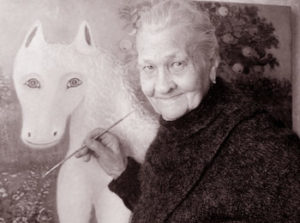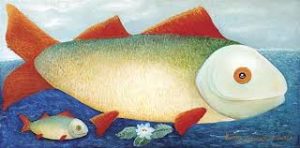
1915 - 2013
Elena Volkova

description
A Russian self-taught artist of Ukrainian origin, one of the most prominent and world famous representatives of amateur art. Elena Volkova was the first naïve artist, whose personal exhibition was held at the State Tretyakov Gallery (December 2005 – January 2006), when she was alive. Valentin Volkov, the artist’s son, initiated and opened her private museum in Moscow. Volkova’s name is included in the English and American Encyclopedias of naïve art.
Key ideas:
– E. Volkova often said to art experts and the press that happy childhood is always on her mind. Although she called each next canvas with the name of the place where her destiny brought her (“Siberian Beauty”, “Gray Wolf on the Moscow River”, “People’s Party on the Irtysh”), she still depicted her Siversky Donets, Chuguev neighbors and relatives, fish caught by her grandfather, animals from the tales of her mother and those who lived at their farmstead. That was her personal paradise; however, any viewer can understand it due to its simplicity and joyfulness.
– Unlike many naïve artists not too painstakingly working on the painting, Volkova took much time to create her works, applying brushstrokes of different shades and ensuring that everything became “alive”. It was not figuratively, but literally. She said that as soon as the deer pushes away the brush with its hoof, she might stop painting it. When painting water, she carefully looked at it. Water has different colors; so, if it started flowing and shining, you can stop painting it.
– The artist’s favourite plot was fish and water. Volkova’s fish is as multi-valued space symbol, as that of Matisse or of nonconformists (for example, for D. Pavlinsky, it was a cross-cutting image). A very large fish crosses the canvas diagonally; above, there is the sky with realistic flowers; there are water lilies and small fish below. So free placement of objects is found both in children’s drawing and in paintings by sophisticated avant-garde artists. This is Volkova’s natural talent, which she received without many years of work and without mastering the rules of painting and image systems.
– Experiencing the world of people and animals as a paradise garden, Volkova naturally moves into the space of universal agreement of everything with everything. According to her, everyone has his own role, color and character and, thus, its own place in the painting. At the same time, she claims that she does not need a model to draw from, as she remembers everyone.
– The artist had an amazing technology – she saw the pictures ready. They “swam by” in her mind; it was not even while she slept. She drew the main contours on the clean paper sheet, and then began to carefully “make them alive” – not matter whether it was a big beast or a small grape. She preferred oil paints, because they took time to dry, so that she could correct what she was painting. Thus, it turned out to be what one could not even dream about – the painting created itself.
– Art experts were impressed by her phrase, “I just want the apple to become round, I touch it and I make sure that the brush goes behind the apple.” So, she was so much inside the painting that her consciousness was in the direct contact with the world she was creating, making it reality. Perhaps, it was only a result of her true love for any blade or stone, for all living. Volkova had no anger, but fully accepted the world.
1915
1930
1940
1950 - 1960
1970
1974 - 1976
1980
1990
2000
2013
The artist was born
She studied according to the educational program and completed accounting courses in Kupyansk

She worked at the military hospital

She lived in Chuguev

She lived in Omsk

Participated in the All-Union Exhibition for the first time

Her paintings were exhibited at six All-Union exhibitions

A permanent exhibition of her works was opened at the gallery of naïve art “Dar”

“Peace to all!”

On October 8, the artist died in Moscow

